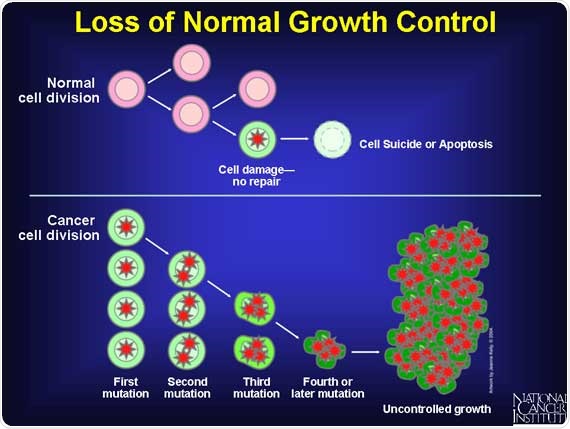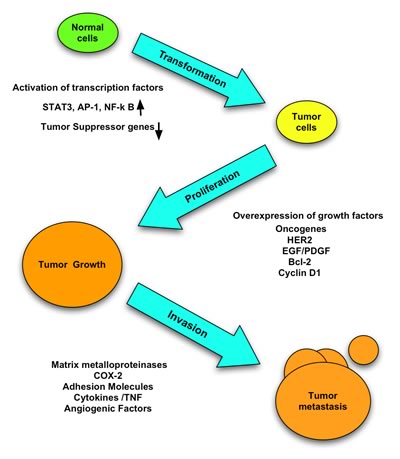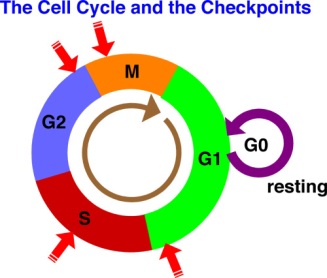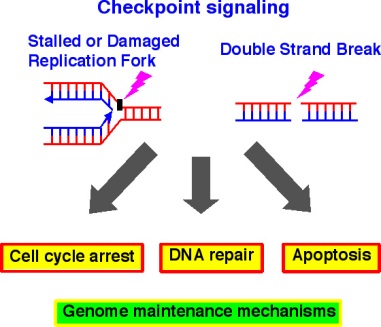Pathology of cancers and other complex disorders have undergone a major change after development of technologies like immunohistochemistry, flow cytometry, and molecular biologic approaches to cancer diagnosis.
What is cancer
Cancer is refers to a group of more than a hundred diseases that can originate in many different parts of the body.
However, the following features are common to all types of cancer:
- Abnormal cell growth
- Capacity to invade other tissues
- Capacity to spread to distant organs via blood vessels or lymphatic channels (metastasis)
How does cancer occur?
The body is made up of trillions of cells that usually grow, divide and die in an organized manner. This process is a tightly controlled by the DNA machinery within the cell. When a person is developing and growing up, cells divide rapidly to allow for growth but once adulthood is reached, cells mainly only divide to replace worn-out or dying cells or to repair injuries.
Cancer occurs when cells in a particular site start to grow out of control. Rather than dying, they continue to grow and form new, abnormal cells. These abnormal cells can also invade other tissues, a property that normal cells do not possess.
Molecular pathology of cancer
Cancer cells originate from normal cells in which the DNA (deoxyribonucleic acid) within the cell nucleus has become damaged or mutated, usually due to the invasion of microbes into healthy cells that have become weakened due to the onslaught of multiple carcinogens, over a period of many years.
DNA is the “blueprint” contained in every cell that carries instructions for the cell’s function, growth, death and protein synthesis. When this DNA becomes damaged, the cell usually either repairs the damage or dies.
However, in cancer cells, the damaged DNA is not repaired and neither does the cell die. Instead, it gives rise to many more abnormal cells that all contain the same defective DNA as the original cancer cell.

DNA damage may be inherited or it may occur spontaneously at any point in a person’s life. DNA damage can be triggered by exposure to certain toxins such as those present in cigarette smoke, for example. There are, however, multiple factors that can cause cancer and it is often difficult to pinpoint an exact cause.
Tumors
As cancer cells proliferate, they eventually form tumors. Not all tumors are cancerous and capable of spreading. Those that are capable of spreading are referred to as malignant tumors. Benign tumors, on the other hand, do not invade other organs or spread to other parts of the body, although they can grow to a large size and start to press on surrounding organs and tissues.
Who gets cancer and how common is cancer?
There are millions of people worldwide who are living with cancer or have had cancer. Estimates suggest that around half of all American men and one third of all American women will develop cancer during their lifetimes. Healthy lifestyle factors can be adopted to help reduce the risk of cancer such as taking regular physical activity, maintaining a healthy diet and body weight and avoiding known risk factors such as exposure to tobacco smoke and too much sunbathing.
For some common cancers such as breast cancer and colon cancer, effective screening tests are available to help detect the disease as early on as possible. Early diagnosis and treatment initiation often improves the chance of a good response to anti-cancer therapy and therefore recovery.
Genetic changes
In normal cells, genes regulate growth, maturity and death of the cells. Genetic changes can occur at many levels. There could be a gain or loss of entire chromosomes or a single point mutation affecting a single DNA nucleotide.
There are two broad categories of genes which are affected by these change:
- Oncogenes – these are cancer causing genes. They may be normal genes which are expressed at inappropriately high levels in patients with cancers or they may be altered or changed normal genes due to mutation. In both cases these genes lead to cancerous changes in the tissues.
- Tumor suppressor genes – these genes normally inhibit cell division and prevent survival of cells that have damaged DNA. In patients with cancer these tumor suppressor genes are often disabled. This is caused by cancer-promoting genetic changes. Typically, changes in many genes are required to transform a normal cell into a cancer cell.
Genomic amplification
Sometimes there may be genomic amplification. Here a cell gains many copies (often 20 or more) of a small chromosomal locus, usually containing one or more oncogenes and adjacent genetic material.
Mutations
Normally, the body safeguards against cancer via numerous methods, such as: apoptosis or a process by which abnormal cells die on their own accord, helper molecules (some DNA polymerases), possibly senescence or aging, etc.
In cancer cells, the damaged DNA is not repaired, and the cell does not die. Instead it gives rise to more such abnormal cells with abnormal DNA. These new cells all have the same defective DNA of the original cancer cell.
DNA damage may be inherited from parents or may be a spontaneous problem that occurs during the lifetime of a person. This is called a mutation. DNA damage may also be triggered by exposure to certain environmental toxins such as those present in cigarette smoke. There are, however, multiple factors that may cause cancer and it is difficult to pin point an exact cause.
Mutations may be:
- Those in the error-correcting machinery of a cell. This may cause accumulation of errors rapidly in the cell and its progeny.
- Those in signaling (endocrine) machinery of the cell. This leads transmission of the error signals to nearby healthy cells as well.
- Those that allow the cells to migrate and disrupt more healthy cells away from the primary site of origin.
- Those that make the cell immortal so that the abnormal cell refuses to die.
Point mutations
Point mutations occur at single nucleotides. There may be deletions, and insertions especially at the promoter region of the gene. This changes the protein coded for by the particular gene. Disruption of a single gene may also result from integration of genomic material from a DNA virus or retrovirus. This may lead to formation of Oncogenes.
Translocation
Translocation is yet another process when two separate chromosomal regions become abnormally fused, often at a characteristic location. A common example is Philadelphia chromosome, or translocation of chromosomes 9 and 22, which occurs in chronic myelogenous leukaemia, and results in production of the BCR-abl fusion protein, an oncogenic tyrosine kinase.
Tumors
A tumor in latin means a swelling but not all swellings are tumors in the modern sense of the term. Some of them may be caused due to inflammation, infections, cysts or fluid filled lesions or due to benign growths. A cancerous tumor has the capacity to grow rapidly and to metastasize or spread to other tissues. Some tumors like leukemias grow as cell suspensions but most grow as solid masses of tissue.
Solid tumors have two distinct parts. One of them is the parenchyma that contains cancer tissues and cells and the other is the stroma that the neoplastic cells induce and in which they are dispersed.
Tumors that originate from epithelial cells have a basal lamina that separates clumps of tumor cells from stroma. However, the basal lamina is often incomplete, especially at points of tumor invasion.
The stroma is juxtaposed between malignant cells and normal host tissues and is essential for tumor growth. The stroma contains nonmalignant supporting tissue and includes connective tissue, blood vessels, and, very often, inflammatory cells. All solid tumors require stroma if they are to grow beyond a minimal size of 1 to 2 mm.
In addition, tumors that are cancerous also have the property of new blood vessel formation. Blood vessels are only one component of tumor stroma. In fact, in many tumors, the bulk of stroma comprises interstitial connective tissue, and blood vessels are only a minor component of the stromal mass. The stroma also contains tissues and cells from blood including water and plasma proteins, together with various types and numbers of inflammatory cells. There are in addition proteoglycans and glycosaminoglycans, interstitial collagens (types I, III, and, to a lesser extent, type V), fibrin, fibronectin, fibroblasts etc.
How Cancer Impacts the Body
Everyone has heard of cancer. When I say the word 'tumor,' be it malignant or otherwise, people immediately think of a lump or bump. That's the generalization of cancer: lumps and bumps. But it's oh so much more - unfortunately much more! How cancer affects the body goes way beyond clusters of cells growing in large masses, as this lesson will explore and point out with some examples.
Physical Forces of Cancer
The lumps and bumps that may grow as a result of cancer aren't there for looks. They can, due to their size, cause some serious physical damage. For instance, as a tumor grows larger and larger, it can cause something known as pressure atrophy, or the wasting away and destruction of tissues as a result of compressive forces.
One notable example of this is a meningioma. This is a benign tumor. You'd think the word 'benign' means it's innocent. The problem is that as it gets larger and larger, it begins to compress the brain and compress important structures and eventually leads to seizures and the death of the individual it affects.
You can simulate pressure atrophy yourself by taking some Play-Doh and rolling it up into a ball. Thereafter, begin by taking a marble and slowly increasing the downward pressure onto the ball of Play-Doh. You'll begin to mush the dough as you do so; that's kind of what happens in pressure atrophy.
Another problem with lumps and bumps will have nothing to do with mushing of organs or tissues. A lump or bump may obstruct important things. One easy-to-picture example is of a big mass growing inside of the intestines. This mass will block the passage of food down the GI tract, leading to a potentially life-threatening back-up of food. In severe cases it may cause the intestines to rupture and lead to a very painful death by way of infected peritonitis, or the inflammation of the membrane that lines the abdominal cavity and many of its organs.
Paraneoplastic Syndromes
There are plenty of other physical problems cancer can cause, such as pressure upon bone causing pain, interfering with the range of motion of a person, and so forth. There are too many to list and we need to move on to something known as a paraneoplastic syndrome in order to appreciate the many different types of problems cancers can cause besides anatomical or physical problems. A paraneoplastic syndrome is an often systemic, or body-wide, clinical problem resulting directly from the presence of cancer cells that is not directly associated with their actual location or their metastasis.
A cancer cell may cause the obstruction of the gastrointestinal tract if it's growing inside of it, just like I mentioned before. That is not a paraneoplastic syndrome because the effect that tumor's growth has on the body is limited to only the local area of the body where it is causing an obstruction. If the cancer spreads to another part of the GI tract and causes a new obstruction there, it's also not a paraneoplastic syndrome because by definition paraneoplastic syndromes aren't as a result of cancer metastasis.
However, if the tumor growing in the GI tract secretes some kind of compound, like a hormone, that spreads around the body and causes your body's tissues, organs, immune system, or metabolism to go crazy, that is a paraneoplastic manifestation of that cancer. Because the spread of the molecule that causes this problem is not dependent on the actual location of the cancer cells themselves, only on the type of cancer that it is as well as what it secretes or the body's immune response to it, it's therefore a paraneoplastic syndrome.
One real-world example of this is when a tumor known as a thymoma may release substances that mimic a compound in our body called ACTH. If there's too much ACTH in the body, it can lead to a disease called Cushing's syndrome.
What Is Leukemia & Where Is It Found?
Leukemia is a cancer of the blood and bone marrow that involves the overproduction of white blood cells. Learn about the different types of leukemia, Acute Lymphocytic, Acute Myelogenous, Chronic Lymphatic and Chronic Myelogenous Leukemia.
Sitting is a pretty basic part of everyday life, but you wouldn't be able to stay upright in your seat if it wasn't for your skeletal system. Without your bony skeleton, your body would have no structure and you would be a blob of tissues that slides off the side of your chair and onto the ground.
Yet bones are not only a means of support. Inside your bones there's a soft, spongy tissue called your bone marrow, which is the site for blood cell production. Your bone marrow makes three types of cells: red blood cells, which carry oxygen around your body; white blood cells, which protect the body from infection and disease; and platelets, which are actually fragments of cells that are important for blood clotting. The bone marrow works very efficiently in most people, producing just enough cells to meet the body's needs.
However, some people develop leukemia, which is a cancer of the blood and bone marrow in which the bone marrow produces many abnormal white blood cells. Leukemia is a fairly easy term to recall if you remember that 'leuk' refers to white cells and 'emia' refers to a condition or having excessive substances in the blood. Therefore, 'leukemia' literally means 'excessive white cells.' The overabundance of white cells crowds out the red blood cells and platelets, and their numbers diminish.
So if we are considering where in the body leukemia starts, we would say that it starts in the bone marrow, but it doesn't necessarily stay in the bone marrow. This is because the abnormal cells can be transported to other areas of the body, such as the lymph nodes, brain, and spinal cord, as well as other organs and tissues.
Cancer PathogenesisGenetic abnormalities found in cancer typically affect two general classes of genes: cancer-promoting oncogenes and tumor suppressor genes.
Cancer-promoting oncogenes are often activated in cancer cells, giving those cells new properties, such as hyperactive growth and division, protection against programmed cell death, loss of respect for normal tissue boundaries, and the ability to become established in diverse tissue environments.
Tumor suppressor genes are often inactivated in cancer cells, resulting in the loss of normal functions in those cells, such as accurate DNA replication, control over the cell cycle, orientation and adhesion within tissues, and interaction with protective cells of the immune system.

There are also many factors involve in cancer pathogenesis.
What is the Checkpoint?
The checkpoints are surveillance mechanism and quality control of the genome to maintain genomic integrity. Checkpoint failure often causes mutations and genomic arrangements resulting in genetic instability. Genetic instability is a major factor of birth defects and in the development of many diseases, most notably cancer.
Cells are constantly under the stress of intrinsic and extrinsic agents that cause DNA damage or interference with DNA replication. To cope with these assaults, cells are equipped with DNA maintenance checkpoints to arrest cell cycle and facilitate DNA repair pathways.
Cancer Risk Factors
The following diagram shows the key risk factors associated with most cancers.
General Cancer Pathogenesis
The following flow diagram is a high-level depiction of how cancer develops in the human body.
Additional Resources
Microbes and Cancer
http://healyourselfathome.com/health_problems/cancer/why/microbial_theory.aspx







